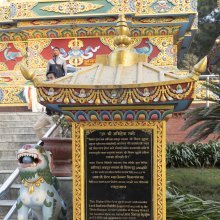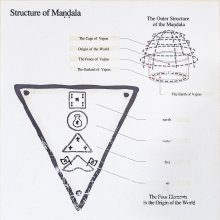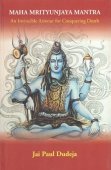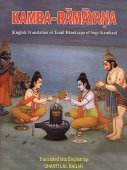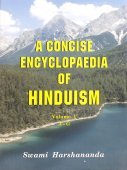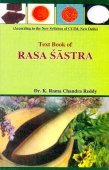Darshana, Darśana: 45 definitions
Introduction:
Darshana means something in Buddhism, Pali, Hinduism, Sanskrit, Jainism, Prakrit, the history of ancient India, Marathi, Hindi. If you want to know the exact meaning, history, etymology or English translation of this term then check out the descriptions on this page. Add your comment or reference to a book if you want to contribute to this summary article.
The Sanskrit term Darśana can be transliterated into English as Darsana or Darshana, using the IAST transliteration scheme (?).
Alternative spellings of this word include Darshan.
Images (photo gallery)
(+5 more images available)
In Hinduism
Vastushastra (architecture)
Source: McGill: The architectural theory of the MānasāraDarśana (दर्शन) refers to “auspicious sight”, to be granted by an image of Śiva to the devotee after performing the ritual of “opening of the eyes”, according to Mānasāra chapter 70.—Just as fire could be bath benign and malignant, it was thought that the gaze of the divine could also potentially have malignant effects if encountered before appeasement through worship. The subsequent rituals (during the “opening of the yes”, see Mānasāra chapter 70) aim at transference of Śiva and his propitiation in the image so that he is placated and his gaze turns entirely benevolent at the instance when the eyes are uncovered, thus granting darśana, “auspicious sight”, to the devotee.
When the enlivening of the image is complete with the deity “transferred” from the main waterpitcher to the image, the cloth is removed so that he offers darśana, “auspicious sight”, to the devotee. The light of divine manifestation shines forth through the eyes of the image, and is received into the heart of the devotee through his own eyes, dispelling the darkness therein, as when the sun rises and spreads its myriad rays around, dispelling the night.
Darśana marks the culmination of devotional worship in Śaivism. The singular intent of the sthapati in his making the temple and image is to realize this sacred program: to manifest the divine and thus facilitate darśana. In this, his whole approach is one of devotion, and from it proceed the perceptual, conceptual and meditative exercises of seeing.
Source: Brill: Śaivism and the Tantric Traditions (architecture)Darśana (दर्शन) refers to the “seeing” (of an omen), according to the Devyāmata (in the section śalyoddhāra-paṭala or “excavation of extraneous substances”).—Accordingly, “[...] When the division of [the sites for] a house and a shrine with cords has been commenced, the wise man [i.e. the officiant] should notice an omen and observe it correctly. [The omens are] seeing (darśana) [someone or something], announcing [a creature’s name], cries [of animals], and the actions of a donor. [The officiant] should carefully notice an extraneous substance as situated beneath the site. [...]”.
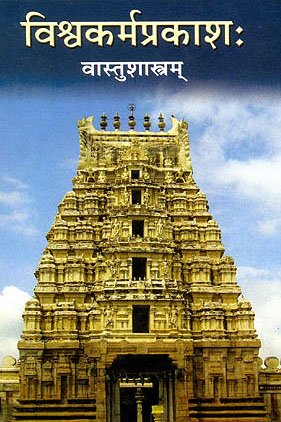
Vastushastra (वास्तुशास्त्र, vāstuśāstra) refers to the ancient Indian science (shastra) of architecture (vastu), dealing with topics such architecture, sculpture, town-building, fort building and various other constructions. Vastu also deals with the philosophy of the architectural relation with the cosmic universe.
Ganapatya (worship of Ganesha)
Source: Google Books: Ganapati: Song of the SelfDarśana (दर्शन) refers to “receiving a blessed sight of the deity”.—A pūjā involves three actions: 1. the devotee presents an offering to the deity, 2. the devotee is granted the blessed sight of (darśana) the deity, 3. the devotee in turn receives a blessed article from the worship (prasāda).
Ganapatya (गाणपत्य, gāṇapatya) represents a tradition of Hinduism where Ganesha is revered and worshipped as the prime deity (ishta-devata). Being a minor though influential movement, Ganapatya evovled, llike Shaktism and Shaivism, as a separate movement leaving behind a large body of literature.
Vaishnavism (Vaishava dharma)
Source: Pure Bhakti: Bhagavad-gita (4th edition)Darśana (दर्शन) refers to “(1) Behold, or meet. It is used in reference to beholding either the deity or advanced devotees. (2) Doctrine, or philosophical system, as in Vedānta-darśana”. (cf. Glossary page from Śrīmad-Bhagavad-Gītā).
Source: Pure Bhakti: Bhajana-rahasya - 2nd EditionDarśana (दर्शन) refers to:—Seeing, meeting, visiting or beholding (especially a deity, a sacred place or an exalted Vaiṣṇava). (cf. Glossary page from Bhajana-Rahasya).
Source: Pure Bhakti: Brhad BhagavatamrtamDarśana (दर्शन) refers to:—A view or audience of a Deity or saintly person. (cf. Glossary page from Śrī Bṛhad-bhāgavatāmṛta).
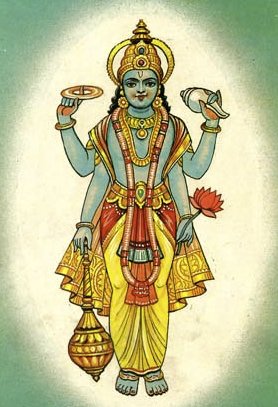
Vaishnava (वैष्णव, vaiṣṇava) or vaishnavism (vaiṣṇavism) represents a tradition of Hinduism worshipping Vishnu as the supreme Lord. Similar to the Shaktism and Shaivism traditions, Vaishnavism also developed as an individual movement, famous for its exposition of the dashavatara (‘ten avatars of Vishnu’).
Ayurveda (science of life)
Source: gurumukhi.ru: Ayurveda glossary of termsDarśana (दर्शन):—1. Looking at, seeing, observing 2. Inspection / examination
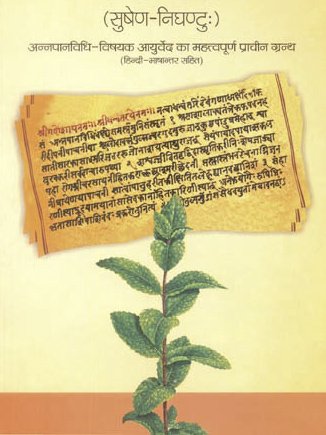
Āyurveda (आयुर्वेद, ayurveda) is a branch of Indian science dealing with medicine, herbalism, taxology, anatomy, surgery, alchemy and related topics. Traditional practice of Āyurveda in ancient India dates back to at least the first millenium BC. Literature is commonly written in Sanskrit using various poetic metres.
Shaktism (Shakta philosophy)
Source: Google Books: Manthanabhairavatantram1) Darśana (दर्शन) refers to “seeing” (the Divine Light), according to the Ṣaṭsāhasrasaṃhitā, an expansion of the Kubjikāmatatantra: the earliest popular and most authoritative Tantra of the Kubjikā cult.—The Ṣaṭsāhasrasaṃhitā supplies a brief description of the Yogic practice by means of which the Accomplishment of Speech, that stimulates the operation of the Command, develops:—“One should meditate on the light that is within the Cavity of Brahmā (between) the eyebrows (kodaṇḍa). [...] Having meditated on it, one conquers Speech. [...] The Command functions by his seeing (darśana) and looking (avalokana) (at the Divine Light). The Accomplishment of Speech, which brings about the immediate possession of men, comes about (spontaneously in this way). It is both speech in Sanskrit and the vulgate. It is the understanding of the wisdom of the scripture. It is attained if one is intent on practice”
2) Darśana (दर्शन) refers to the “(four) philosophies”, according to the Manthānabhairavatantra, a vast sprawling work that belongs to a corpus of Tantric texts concerned with the worship of the goddess Kubjikā.—Accordingly: “You are the first Śaṃkara of this Age who has emerged in Ahicchatra. You are the son of Śrīdhara and, initiated into the four Vedas, you have emerged out of (these) four ‘philosophies’ (catur-darśana) with the name Śaṃkara”.
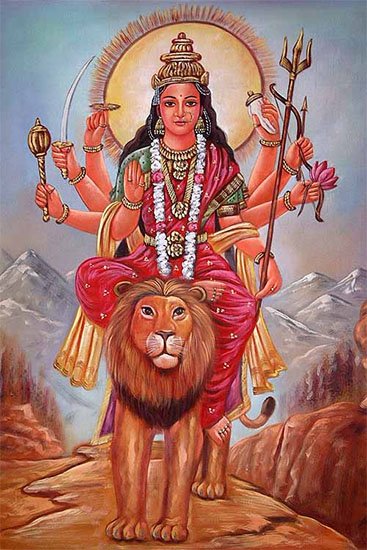
Shakta (शाक्त, śākta) or Shaktism (śāktism) represents a tradition of Hinduism where the Goddess (Devi) is revered and worshipped. Shakta literature includes a range of scriptures, including various Agamas and Tantras, although its roots may be traced back to the Vedas.
Vedanta (school of philosophy)
Source: Google Books: Studies on the MoksopayaDarśana (दर्शन) refers to “perception”, according to the 10th century Mokṣopāya or Mokṣopāyaśāstra 6.182.13-17.—Accordingly, “With regard to each of [the three:] perceiver (draṣṭṛ), perception (darśana) and perceived objects (dṛśya), the state of mere knowledge [i.e., bodhamātra] is the essence; therefore there is not in the least a difference from it (i.e. knowledge), like a flower in space (is not different from space). (13) What is of the same kind becomes one. Therefore mutual perception [of things] determines their unity. (14) If wood, stones and other [material objects] did not have knowledge as their nature, then there would be a permanent nonperception of these, which would even be nonexistent. (15) When the whole beauty of perceptible objects has but one form of mere knowledge, then, whether it is different or identical, it becomes known through knowledge. (16) This whole [group of] perceptible objects in the world has expanded [as] mere knowledge, just as wind is mere movement and the ocean mere water. (17)”.
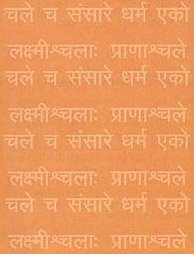
Vedanta (वेदान्त, vedānta) refers to a school of orthodox Hindu philosophy (astika), drawing its subject-matter from the Upanishads. There are a number of sub-schools of Vedanta, however all of them expound on the basic teaching of the ultimate reality (brahman) and liberation (moksha) of the individual soul (atman).
Ganitashastra (Mathematics and Algebra)
Source: archive.org: Hindu MathematicsDarśana (दर्शन) represents the number 6 (six) in the “word-numeral system” (bhūtasaṃkhyā), which was used in Sanskrit texts dealing with astronomy, mathematics, metrics, as well as in the dates of inscriptions and manuscripts in ancient Indian literature.—A system of expressing numbers by means of words arranged as in the place-value notation was developed and perfected in India in the early centuries of the Christian era. In this system the numerals [e.g., 6—darśana] are expressed by names of things, beings or concepts, which, naturally or in accordance with the teaching of the Śāstras, connote numbers.
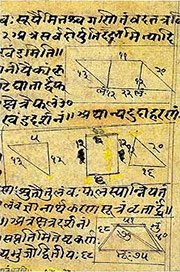
Ganita (गणित) or Ganitashastra refers to the ancient Indian science of mathematics, algebra, number theory, arithmetic, etc. Closely allied with astronomy, both were commonly taught and studied in universities, even since the 1st millennium BCE. Ganita-shastra also includes ritualistic math-books such as the Shulba-sutras.
Shaivism (Shaiva philosophy)
Source: SOAS University of London: Protective Rites in the Netra TantraDarśana (दर्शन) refers to “seeing (a deity)” (in a dream), according to the Svacchanda-tantra.—Accordingly, [verse 4.3-6, while describing the interpretation of dreams]—“In [auspicious] dreams [the dreamer] drinks wine, eats raw flesh, smears insect feces and sprinkles blood. He eats food of sour milk and smears a white garment. [He holds] a white umbrella over his head, decorates [himself] with a white garland or ribbon. [He sees] a throne, chariot or vehicle, the flag of royal initiation. He decorates [these things] with a coral, betel leaf fruit. [He also] sees (darśana) Śrī or Sarasvatī”.
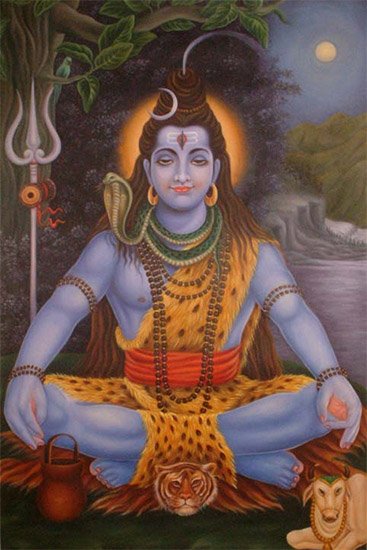
Shaiva (शैव, śaiva) or Shaivism (śaivism) represents a tradition of Hinduism worshiping Shiva as the supreme being. Closely related to Shaktism, Shaiva literature includes a range of scriptures, including Tantras, while the root of this tradition may be traced back to the ancient Vedas.
Yoga (school of philosophy)
Source: ORA: Amanaska (king of all yogas): A Critical Edition and Annotated Translation by Jason BirchDarśana (दर्शन) refers to “seeing (the highest reality)”, according to the Haṭhapradīpikā of Svātmārāma: an influential 15th-century Sanskrit manual on Hatha-Yoga dealing with techniques to channel one’s vital energy.—Accordingly, “Giving up sense objects is difficult to achieve; seeing the highest reality (tattva-darśana) is [also] difficult, and [so too] is attaining the natural state [of Samādhi], without the compassion of a true Guru”.

Yoga is originally considered a branch of Hindu philosophy (astika), but both ancient and modern Yoga combine the physical, mental and spiritual. Yoga teaches various physical techniques also known as āsanas (postures), used for various purposes (eg., meditation, contemplation, relaxation).
Dharmashastra (religious law)
Source: archive.org: History of Dharmasastra (Vol II Part I)Darśana (दर्शन) refers to “pointing out (the Pole star and Arundhatī)” (to the bride at night on the day of marriage)” and represents one of the various Marriage Rites (saṃskāra) according to the Āśvalāyana-gṛhya-sūtra I.7.22—The main outlines of the marriage saṃskāra show a remarkable continuity for several thousand years from the times of the Rig Veda down to modern times.—Dhruvārundhatī-darśana refers to “pointing out the Pole star and Arundhatī to the bride at night on the day of marriage”. Āśvalāyana-gṛhya-sūtra I.7.22 speaks of the seven sages in addition, Mānava-gṛhya-sūtra I.14.9 speaks of the same three and adds Jīvantī, Bharadvāja-gṛhya-sūtra 1.19 speaks of Dhruva, Arundhatī and other nakṣatras, Āpastamba-gṛhya-sūtra VI.12 (only Dhruva and Arundhatī), Par. I.8 (only Dhruva). According to Saṅkhyāyana-gṛhya-sūtra 1.17.2, Hiraṇyakeśi-gṛhya-sūtra I.22.10 both the bride and the bride-groom remain silent till night. According to Āśvalāyana-gṛhya-sūtra only the bride does so. Gobhila-gṛhya-sūtra II.3.8-12 describes dhruvārundhatī-darśana before gṛha-pravesa.
Source: Oxford Academic: Homo Ritualis: Hindu Ritual and Its Significance to Ritual TheoryDarśana (दर्शन) refers to “looking (at the sun)” and represents one of the various marriage rites of the Hindu Newars, mentioned in the Daśakarmavidhi: a marriage handbook from Bhaktapur containing both Hindu and Newar marriage ceremonies.—Despite many congruencies between Hindu Parbatiyā and Hindu Newar marriage handbooks, it becomes evident that Newar marriage handbooks mention specific ritual elements that cannot be found in the Brahmanical-Sanskritic texts.—The Sūrya-darśana rite is usually performed at the House of the Groom and is mentioned under the sub-heading of “other marriage rites”.
Udīkṣaṇa has the following synonyms: Darśana.

Dharmashastra (धर्मशास्त्र, dharmaśāstra) contains the instructions (shastra) regarding religious conduct of livelihood (dharma), ceremonies, jurisprudence (study of law) and more. It is categorized as smriti, an important and authoritative selection of books dealing with the Hindu lifestyle.
Pancaratra (worship of Nārāyaṇa)
Source: archive.org: Catalogue of Pancaratra Agama Texts1) Darśana (दर्शन) refers to “witnessing (the great festival)”, as discussed in the eleventh chapter [first book] of the Jñānāmṛtasārasaṃhita: a Pāñcarātra text representing a sectarian glorification of Kṛṣṇa and Rādha (i.e., the cult of Radha-Krishna) dated among the latest of the Saṃhitā-type works.—Description of the chapter [mahāotsava-darśana]: Continuing the flash-back within a flash-back of the preceding chapter, Vyāsa here tells of how Nārada in his former birth as Upavarhaṇa sang praises of the rasa-dance of Kṛṣṇa and of His sports, etc. The song was well-received by all the heavenly hosts who heard it, and their acclaim of it is what constituted the “mahotsava” (1-39).
2) Darśana (दर्शन) refers to the “viewing of Viṣṇu at various times”, as discussed in the fourth chapter of the Paramapuruṣasaṃhitā: a Pāñcarātra text in ten chapters composed of 940 verses dealing with the personnel of a temple, their prerequisites and duties, their different ranks, the privileges and responsibilities of each etc.—Description of the chapter [bhagavattīrtha-prasādādika-mahima-varṇana]: The Ṛṣis want to know about the details of sacramental offerings made and received in temples (1-4a). [...] Since grace comes to men also simply through beholding the Lord in his icon-form, Nārada then discusses darśana-viewing of Viṣṇu at various times (59-74, 175-179). As well, merit derives from accepting other offerings given first to the Lord then divided up for distribution among His devotees—like tulasī-leaves, the pavitra-garlands, cosmetics of the Goddess, etc. (75-84). [...]
3) Darśana (दर्शन) refers to the “vision (of the abode of release)”, as discussed in chapter 5 of the (third section of the) Bṛhadbrahmasaṃhitā: a Pāñcarātra text containing over 4600 Sanskrit verses dealing primarily with Vaiṣṇava theology and practical matters concerning the Śrī-Vaiṣṇava community but also discussing aspects of Viśiṣṭādvaita philosophy.—Description of the chapter [muktimaṇḍapa-darśana]: The bulk of this chapter is devoted to a description of the great pavilion in which the Lord abides—its special features, its furnishings, its luxurious fragrances and entertainments, its eternal inhabitants who live there in rapturous devotion to the Master, etc. (1-31). [...]
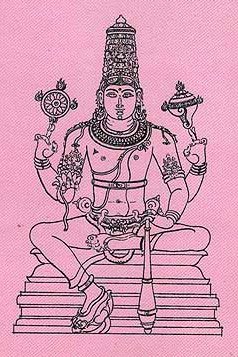
Pancaratra (पाञ्चरात्र, pāñcarātra) represents a tradition of Hinduism where Narayana is revered and worshipped. Closeley related to Vaishnavism, the Pancaratra literature includes various Agamas and tantras incorporating many Vaishnava philosophies.
General definition (in Hinduism)
Source: Google Books: Manthanabhairavatantram (philosophy)Darśana (दर्शन) literally means “the act of seeing or viewing”. It also means “a philosophical system”, which in India, according to the nature of the system, may be more or less theological, logical, systematic, theistic, atheist, related to a religious tradition or independent. The word appears in the titles of compendiums of such systems. [...] Darśana in the modern North Indian vernaculars denotes the act of going to visit a deity in a temple or a saintly person just as one would say in English ‘going to see someone’. Thus, darśana, which literally means ‘vision, insight, and seeing’, in this sense is ‘a meeting with the being who is seen and who sees’. Moreover, it has the added connotation in that context of a spiritual ‘vision’.
Source: ruthaavaree: Overview of Śaivāgamas in Temple WorshipDarśana (दर्शन).—What does a devotee do in a Hindu temple? He/she comes to have darśana–to see and be seen by the Lord, to be in the presence of the Lord and partake of the Divine Energy.
Source: Shodhganga: A study of Nyāya-vaiśeṣika categories (h)Darśana (दर्शन).—Philosophy is known as darśana or “vision of truth” in India. The word darśana is derived from the root √dṛś which means ‘vision’ and also the ‘instrument of vision’. It stands for the direct immediate and intuitive vision of truth. That from which we find real knowledge is known as darśana. The philosophical purpose in India is to observe the nature of the reality as a whole.
The origin of Indian Philosophy (darśana) is found in the Vedas. Among the Vedas mainly the Ṛgveda is the fountain head of it. We find that, from the earliest time of the Ṛgveda, Indian seers became involved in philosophical speculations and the result of their attempts are found embodied in the Puruṣasūkta, the Devīsūkta, the Nāsadīyasūkta etc. “The Puruṣasūkta and Devīsūkta contain the germ of Monistic Idealism while the Śūktas ascribed to Dirghatamas contain the germ of Dualistic Realism”.
Thus, six well-known systems of Indian philosophy [flourished], namely—
- Sāṃkhya,
- Yoga,
- Nyāya,
- Vaiśeṣika,
- Mīmāṃsā,
- Vedānta.
The root of some systems is Monistic Idealism others is Dualistic Realism. All these six systems are known as the āstika or the orthodox systems as they accept the authority of the Vedas. Some other systems of Indian Philosophy (darśana) do not accept the Vedic authority. These systems are called nāstika or heterodox systems, viz. the Bauddha, the Jaina and the Cārvāka.
In Buddhism
Mahayana (major branch of Buddhism)
Source: Wisdom Library: Maha Prajnaparamita SastraDarśana (दर्शन) or Darśanabhūmi refers to “ground of seeing or of Srotaāpanna” and represents one of the ten grounds (bhūmi) shared by adepts of the three vehicles according to the 2nd century Mahāprajñāpāramitāśāstra chapter 52.—Darśana-bhūmi (mthoṅ baḥi sa, kien or kiu kien) is one of the ten grounds shared by adepts of the three Vehicles (sādhāraṇabhūmi). For the Śrāvaka, this is the obtaining for the first time of a fruit of sainthood (āryaphala), namely, Srotaāpanna.—For the Bodhisattva, it is the Bodhisattva ground of non-regressing (avaivartika). [It coincides with the shared ground no. 8, the Acalā).
Source: academia.edu: A Study and Translation of the Gaganagañjaparipṛcchā1) Darśana (दर्शन) refers to “looking at”, according to the Gaganagañjaparipṛcchā: the eighth chapter of the Mahāsaṃnipāta (a collection of Mahāyāna Buddhist Sūtras).—Accordingly, “The great vehicle (mahāyāna) is made with four wheels, namely with the means of attraction, the spokes are well fitted as the roots of good have been transformed with intention, [...] it is applied with practical knowledge and wisdom, it is driven by an autopilot, all Buddhas in ten directions think of it, it is well adorned with a lion’s throne, is praised by all the gods (deva), the king of the gods, and the highest god, has good visual form that one never be satisfied with looking at (atṛpta-darśana), is beautiful to behold (darśanīya), [...]”.
2) Darśana (दर्शन) refers to “seeing (the Buddha)”, according to the Gaganagañjaparipṛcchā.—Accordingly, as the Lord said to Brahmā Prabhāvyūha: “[...] (8) Further, ‘the root of good’ is seeing the Buddha (buddha-darśana), ‘merit’ is worshiping the Buddha, and ‘knowledge’ is relying on the Buddha. Further, ‘the root of merit’ is to become a renunciant, ‘merit’ is to be pleased with the [fourfold] sources of holiness, and ‘knowledge’ is to be pleased in hermits. [...]”.
Source: De Gruyter: A Buddhist Ritual Manual on AgricultureDarśana (दर्शन) refers to the “appearance (of a Nāga-king)” (as part of an offering ritual), according to the Vajratuṇḍasamayakalparāja, an ancient Buddhist ritual manual on agriculture from the 5th-century (or earlier), containing various instructions for the Sangha to provide agriculture-related services to laypeople including rain-making, weather control and crop protection.—Accordingly, [as the Bhagavān teaches the offering of the root spell], “[...] When 1,008 recitations have been made, all great Nāga kings are subdued. They will always appear (darśana). They will always provide all that is wished for. They accomplish everything in detail. All retinues of kinsmen with children and grandchildren are subdued. They do everything that is desired. They guard him as if it were their own home”.
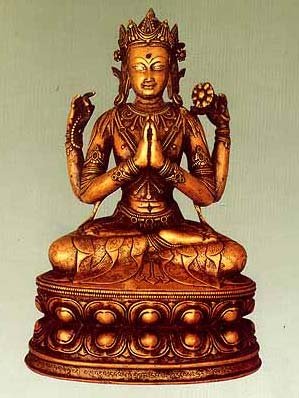
Mahayana (महायान, mahāyāna) is a major branch of Buddhism focusing on the path of a Bodhisattva (spiritual aspirants/ enlightened beings). Extant literature is vast and primarely composed in the Sanskrit language. There are many sūtras of which some of the earliest are the various Prajñāpāramitā sūtras.
In Jainism
General definition (in Jainism)
Source: Wisdom Library: JainismDarśana (दर्शन) refers to “to see beautiful things” and is one of the twenty-four activities (kriyā) of sāmparāyika (transmigression-extending influx). Sāmparāyika is one two types of āsrava (influx) which represents the flow of karma particles towards the soul, which is due to the three activities: manoyoga ( activities of mind), kāyayoga ( activities of body) and vacanayoga (activities of speech).
Kriyā (‘activities’, such as darśana) is a Sanskrit technical term defined in the Tattvārthasūtra (ancient authorative Jain scripture) from the 2nd century, which contains aphorisms dealing with philosophy and the nature of reality. Source: Wisdom Library: JainismDarśana (दर्शन) or Darśanapratimā represents the first of eleven pratimā (stages) laid down for Jain laymen. Darśana-pratimā refers to “possessing the perfect, intelligent and well-reasoned faith in Jainism, that is, having a sound knowledge of its doctrines and their applications in life” according to J. L. Jaini in his “outlines of Jainism” (pp. 67-70).
These pratimās (e.g., darśana) form a series of duties and performances, the standard and duration of which rises periodically and which finally culminates in an attitude resembling monkhood. Thus the pratimās rise by degrees and every stage includes all the virtues practised in those preceeding it. The conception of eleven pratimās appears to be the best way of exhibiting the rules of conduct prescribved for the Jaina laymen.
Source: Google Books: Jaina Scriptures and PhilosophyDarśana is a pramāṇa (instrument of knowledge), because it is not contradicted, the appearance (pratibhāsa) is both a pramāṇa and not a pramāṇa, because one perceives the form of both contradiction and non-contradiction. Or [in other words] the function/activity (vṛtti) of seeing/looking is darśana.
Source: Encyclopedia of Jainism: Tattvartha SutraDarśana (दर्शन, “look”).—What is the meaning of darśana? Literal meaning of darśana are to look / to be seen/ to visualize/ viewpoint and also philosophy. However when prefixed by the word right (samyak), it convey the meaning ‘faith’.
Source: HereNow4U: Śrāvakācāra (Ethics of the Householder)Darśana (दर्शन) refers to one of the eleven pratimās (eleven stages for becoming excellent śrāvaka).—The fist stage is Darśana-pratimā. After the attainment of Samyagdarśana the aspirant who should be styled Dārśanika-śrāvaka resolutely forsakes the use of odious things such as meat, wine and the like, and becomes indifferent to worldly and heavenly pleasures, and nourishes the spirit of detachment. If we subtract the attainment of Samyagdarśana from this stage we shall get the eleven stages of moral advancement in contradistinction to the eleven stages of spiritual advancement owing to Samyagdarśana.
Source: The University of Sydney: A study of the Twelve ReflectionsDarśana (दर्शन) (in Prakrit: Daṃsaṇa). refers to “right faith”—Mūlācāra 744 (vol. 2, p. 26), for instance, states that wrong belief, lack of restraint, passions, and activities of body, mind and speech are prevented by right faith (daṃsaṇa/darśana), restraint, arresting and control, respectively. Bārasa Aṇupekkhā 61-3 include similar statements.—Cf. Hemacandra (Yogaśāstra 4.81-5 [vol. 2, p. 871-3]).

Jainism is an Indian religion of Dharma whose doctrine revolves around harmlessness (ahimsa) towards every living being. The two major branches (Digambara and Svetambara) of Jainism stimulate self-control (or, shramana, ‘self-reliance’) and spiritual development through a path of peace for the soul to progess to the ultimate goal.
India history and geography
Source: Google Books: Manthanabhairavatantram (history)Darśana (दर्शन) denotes what could be called, broadly speaking, a religion or religious tradition and so entails the same problems of definition that we encounter when trying to define what religion is in India in general. In this sense, darśana denotes both a larger generic identity—what we call ‘religion’—as well as a specific one—what might be called a ‘cult’ with relation to a specific deity, or a ‘sect’. Thus the religions, Buddhism and Jainism, are referred to as darśanas, just as schools of Śaivism are. The same term may also be used to denote a particular phase of a religion as in the expression ‘vaidikadarśana’.
Source: Cologne Digital Sanskrit Dictionaries: Indian Epigraphical GlossaryDarśana.—(IE 8-5; EI 32, 33), a levy; same as Persian nazrāna. Cf. Tamil tariśana-kāṇikkai (SITI), presents offered to a king or a chief when one meets him. (CII 1), used in the sense of pradarśana, ‘showing’. (IE 7-1-2), ‘six’; cf. dṛṣti, ‘two’. (IA 14), used in the sense of ‘a religious procession for the purpose of visiting a deity’. Note: darśana is defined in the “Indian epigraphical glossary” as it can be found on ancient inscriptions commonly written in Sanskrit, Prakrit or Dravidian languages.
Source: Yale Journal of Music & Religion: Ritual Music in Contemporary Brahmanical Tantric Temples of KeralaDarśana (दर्शन) refers to “catching a sight” (of the deity).—Daily pūjā in Kerala includes several phases. [...] Then, as he previously did on his own body, he installs the different mantras into the body of the idol. Soon after that he offers various kinds of honorary services to the deity, worships him/her, and offers food. While the main door of the shrine is still closed, at the time of the offering of honorary services, a Mārār musician standing near the steps of the śrīkōvil offers royal music, playing specific compositions on the iṭakka hourglass drum. At the end of this offering the priest opens the door, and devotees catch sight (darśana) of the deity and exit the inner enclosure of the temple. [...]

The history of India traces the identification of countries, villages, towns and other regions of India, as well as mythology, zoology, royal dynasties, rulers, tribes, local festivities and traditions and regional languages. Ancient India enjoyed religious freedom and encourages the path of Dharma, a concept common to Buddhism, Hinduism, and Jainism.
Languages of India and abroad
Marathi-English dictionary
Source: DDSA: The Molesworth Marathi and English Dictionarydarśana (दर्शन).—n (S) Sight or seeing: also looking. 2 A dream or vision. 3 A common term for six religious or philosophical systems. 4 Visiting any idol or sacred shrine.
Source: DDSA: The Aryabhusan school dictionary, Marathi-Englishdarśana (दर्शन).—n Sight; or seeing, looking. Visit- ing any idol or sacred shrine. A visit gen. A dream or vision.
Marathi is an Indo-European language having over 70 million native speakers people in (predominantly) Maharashtra India. Marathi, like many other Indo-Aryan languages, evolved from early forms of Prakrit, which itself is a subset of Sanskrit, one of the most ancient languages of the world.
Sanskrit dictionary
Source: DDSA: The practical Sanskrit-English dictionaryDarśana (दर्शन).—&c. See under दृश् (dṛś).
See also (synonyms): darśa, darśaka.
--- OR ---
Darśana (दर्शन).—a. [dṛś-lyuṭ]
1) Seeing, looking at (at the end of comp.); देव°, धर्म° (deva°, dharma°), &c.
2) Showing, exhibiting.
3) Demonstrating, teaching; भागवतधर्मदर्शना नव महाभागवताः (bhāgavatadharmadarśanā nava mahābhāgavatāḥ) Bhāgavata 5.4.12.
-nam 1 Looking at, seeing, observing; अतीन्द्रियेष्वप्युपपन्नदर्शनो बभूव भावेषु दिलीपनन्दनः (atīndriyeṣvapyupapannadarśano babhūva bhāveṣu dilīpanandanaḥ) R.3.41.
2) Knowing, understanding, perceiving, foreseeing; प्रमदा- मनु संस्थितः शुचा नृपतिः सन्निति वाच्यदर्शनात् (pramadā- manu saṃsthitaḥ śucā nṛpatiḥ sanniti vācyadarśanāt) R.8.72.
3) Sight, vision; चिन्ताजडं दर्शनम् (cintājaḍaṃ darśanam) Ś.4.6.
4) The eye.
5) Inspection, examination; बलानां दर्शनं कृत्वा सेनान्या सह चिन्तयेत् (balānāṃ darśanaṃ kṛtvā senānyā saha cintayet) Y.1.329.
6) Showing, displaying, exhibition.
7) Becoming visible; रावणिः पितरं युद्धे दर्शनस्थोऽब्रवीदिदम् (rāvaṇiḥ pitaraṃ yuddhe darśanastho'bravīdidam) Rām.7.29.32.
8) Visiting, paying a visit, a visit; देवदर्शनम् (devadarśanam) Y.1.84.
9) (Hence) Going into the presence of, audience; मारीचस्ते दर्शनं वितरति (mārīcaste darśanaṃ vitarati) Ś.7; राजदर्शनं मे कारय (rājadarśanaṃ me kāraya) &c.
1) Colour, aspect, appearance, semblance, अनेकाद्भुतदर्शनम् (anekādbhutadarśanam) Bhagavadgītā (Bombay) 11.1; R.3.57.
11) Appearance, producing (in court); यो यस्य प्रतिभूस्तिष्ठेद्दर्शनायेह मानवः (yo yasya pratibhūstiṣṭheddarśanāyeha mānavaḥ) Manusmṛti 8.158,16.
12) A vision, dream, dream.
13) Discernment, understanding, intellect; सम्यग्दर्शन- संपन्नः कर्मभिर्न निबध्यते (samyagdarśana- saṃpannaḥ karmabhirna nibadhyate) Manusmṛti 6.74.
14) Judgment, apprehension.
15) Religious knowledge.
16) A doctrine or theory prescribed in a system.
17) A system of philosophy; as in सर्वदर्शनसंग्रह (sarvadarśanasaṃgraha).
18) A mirror.
19) Virtue, moral merit.
2) Opinion; अथानुजं भृशमनुशास्य दर्शनम् (athānujaṃ bhṛśamanuśāsya darśanam) Rām.2.21.64.
21) Intention.
22) Demonstration.
23) A sacrifice.
24) Mention, assertion; दर्शनादर्शन- योश्च दर्शनं प्रमाणम् (darśanādarśana- yośca darśanaṃ pramāṇam) ŚB. on MS.1.7.36.
25) Experiencing; भवतो दर्शनं यत्स्यादपुनर्भवदर्शनम् (bhavato darśanaṃ yatsyādapunarbhavadarśanam) Bhāgavata 8.25.
Source: Cologne Digital Sanskrit Dictionaries: Edgerton Buddhist Hybrid Sanskrit DictionaryDarśana (दर्शन).—nt., once m. (Sanskrit nt., not in these senses; compare °nā), (1) nt., = dṛṣṭi, false, heretical view: tasyedaṃ dar- śanaṃ abhūt, śubhāśubhānāṃ karmāṇāṃ phalam nāstīti niścayaḥ Mahāvastu i.178.11 (verse); (2) once m. (= Pali dassana, nt., in sippa-d°), exhibition (of skill in arts or exercises): kumāro…darśanaṃ dāsyati Mahāvastu ii.73.18; 74.4, 7; kumā- reṇa…darśano dinnaḥ 75.18; darśana-śatāni vartanti iii.57.9, hundreds of exhibitions (as entertainments at a festival).
--- OR ---
Darśanā (दर्शना).—(nowhere recorded) = Sanskrit °na, nt., sight: (yāye) prabhāye samanvāgataṃ yāye śūkṣma-darśanāye samanvāgataṃ yāye tattva-darśanāye samanvāgataṃ… Mahāvastu i.158.9 (prose); perhaps nonce-form, attracted to gender of prec. prabhāye (the suffix -anā, f., is not rare in other forms beside -ana, nt.).
Source: Cologne Digital Sanskrit Dictionaries: Shabda-Sagara Sanskrit-English DictionaryDarśana (दर्शन).—n.
(-naṃ) 1. Sight, seeing, looking. 2. The eye. 3. A Mirror. 4. Showing. 5. Aspect, appearance. 6. Directing, instructing. 7. A dream, a vision. 8. Virtue, moral merit. 9. Knowledge, especially religious. 10. Understanding, intellect. 11. A Sastra, one of six religious or philosophical systems, the Patanjala, Sankhya, Vaiseshika, Nyaya, Mimansa, and Vedanta. 12. Sacrifice. 13. Colour. 14. Visiting any sacred shrine, worshipping in the presence of any image. E. dṛś to see, affix bhāvakaraṇādau lyuṭ .
Source: Cologne Digital Sanskrit Dictionaries: Benfey Sanskrit-English DictionaryDarśana (दर्शन).—i. e. dṛś + ana, I. adj. 1. Looking on, [Raghuvaṃśa, (ed. Stenzler.)] 11, 93, v. r. 2. Knowing, Mahābhārata 13, 3254. 3. Teaching, Mahābhārata 1, 583. Ii. n. 1. Seeing, [Suśruta] 2, 158, 10. āditya-, Exposure to the sun, [Mṛcchakaṭikā, (ed. Stenzler.)] 47, 5. 2. Sight, Mahābhārata 13, 961; [Śākuntala, (ed. Böhtlingk.)] 18, 18; a vision, [Rāmāyaṇa] 5, 27, 8; a dream, [Harivaṃśa, (ed. Calc.)] 1285. 3. Adoration, [Kathāsaritsāgara, (ed. Brockhaus.)] 3, 8. 4. Appearance, [Mānavadharmaśāstra] 2, 101; with the vbs. i and yā, To become visible, [Bhāgavata-Purāṇa, (ed. Burnouf.)] 1, 6, 34; with dā, To show one’s self, [Gītagovinda. ed. Lassen.] 3, 9. 5. Review, [Yājñavalkya, (ed. Stenzler.)] 1, 328; inspection, [Mānavadharmaśāstra] 8, 9. 6. Knowledge, [Mānavadharmaśāstra] 6, 74. 7. Opinion, Kām. Nītis. 2, 6. 8. Precept, Mahābhārata 14, 2700. 9. Doctrine, [Bhāgavata-Purāṇa, (ed. Burnouf.)] 1, 5, 8. 10. A philosophical system, [Lassen, Anthologia Sanskritica.] 29, 7. 11. Intention, [Rāmāyaṇa] 1, 58, 18. 12. An eye, [Śākuntala, (ed. Böhtlingk.)] [distich] 81. 13. A mirror, [Meghadūta, (ed. Gildemeister.)] 59, v. r. 14. Showing, [Lassen, Anthologia Sanskritica.] 87, 3. 15. Producing, [Yājñavalkya, (ed. Stenzler.)] 2, 170. 16. abl. darśanāt, From, [Raghuvaṃśa, (ed. Stenzler.)] 12, 60. Iii. f. nī, Epithet of Durgā, [Harivaṃśa, (ed. Calc.)] 10238.
Source: Cologne Digital Sanskrit Dictionaries: Cappeller Sanskrit-English DictionaryDarśana (दर्शन).—[feminine] ī (—°) = darśaka; [neuter] seeing, looking, observing; sight, view, vision; appearance, (also in court), occurrence; apparition, dream; visit, meeting with ([genetive], [instrumental] ±saha or —°); trying, examining, understanding; judgment, opinion, knowledge, doctrine; showing, eye.
Source: Cologne Digital Sanskrit Dictionaries: Monier-Williams Sanskrit-English Dictionary1) Darśana (दर्शन):—[from darśa] mf(ī)n. showing, [Pāṇini 5-2, 6]
2) [v.s. ...] ifc. seeing, looking at (See tulya-, deva-, sama-.), [Raghuvaṃśa xi, 93]
3) [v.s. ...] ‘knowing’, See dharma-
4) [v.s. ...] exhibiting, teaching, [Mahābhārata i, 583; Bhāgavata-purāṇa v, 4, 11]
5) [v.s. ...] n. seeing, observing, looking, noticing, observation, perception, [Ṛg-veda i, 116, 23; Śatapatha-brāhmaṇa xiv; Śāṅkhāyana-gṛhya-sūtra v, 5; Mahābhārata] etc.
6) [v.s. ...] ocular perception, [Suśruta iv, 27]
7) [v.s. ...] the eye-sight, [vi, 17]
8) [v.s. ...] inspection, examination, [Yājñavalkya 1, 328; Harivaṃśa 5460]
9) [v.s. ...] visiting, [Yājñavalkya i, 84; Kathāsaritsāgara iii, 8]
10) [v.s. ...] audience, meeting (with [genitive case] [Cāṇakya]; [instrumental case] with or without saha, [Vetāla-pañcaviṃśatikā]; in [compound] [Raghuvaṃśa xii, 60]), [Śakuntalā v, 5/6; vii, 25/26; Rājataraṅgiṇī vi, 43]
11) [v.s. ...] experiencing, [Bhāgavata-purāṇa i, 8, 25]
12) [v.s. ...] foreseeing, [Raghuvaṃśa viii, 71]
13) [v.s. ...] contemplating, [Manu-smṛti viii, 9 and 23]
14) [v.s. ...] apprehension, judgement, [Śakuntalā iii, 6/7] discernment, understanding, intellect, [Manu-smṛti vi, 74; Yājñavalkya i, 8; Bhagavad-gītā] etc.
15) [v.s. ...] opinion, [Mālavikāgnimitra v, 13/14; Kāmandakīya-nītisāra ii, 6]
16) [v.s. ...] intention (cf. pāpa-), [Rāmāyaṇa i, 58, 18]
17) [v.s. ...] view, doctrine, philosophical system (6 in number, viz. [Pūrva-] Mīmāṃsā by, [Jaimini] Uttara-Mīmāṃsā> by, [Bādarāyaṇa’s Brahma-sūtra]; Nyāya by Gotama, [Vaiśeṣika] by Kaṇāda Sāṃkhya by, [Kapila]; Yoga by, [Patañjali]), [Mahābhārata xii, 11045 f.; Bhāgavata-purāṇa] etc.
18) [v.s. ...] the eye, [Suśruta v, 8; Śakuntalā iv, 6; Prabodha-candrodaya iii, 10]
19) [v.s. ...] the becoming visible or known, presence, [Āśvalāyana-gṛhya-sūtra iii, 7; Manu-smṛti ii, 101; iv; Yājñavalkya i, 131; ii, 170; Mahābhārata] etc.
20) [v.s. ...] appearance (before the judge), [Manu-smṛti viii, 158; Yājñavalkya ii, 53; Kāmandakīya-nītisāra]
21) [v.s. ...] the being mentioned (in any authoritative text), [Kātyāyana-śrauta-sūtra i, xxvi; Lāṭyāyana vi, ix; Bādarāyaṇa’s Brahma-sūtra i, s, 25; Mahābhārata xiv, 2700]
22) [v.s. ...] a vision, dream, [Harivaṃśa 1285; Hitopadeśa iii, 0/1]
23) [v.s. ...] ifc. appearance, aspect, semblance, [Manu-smṛti ii, 47; Mahābhārata] ([Nalopākhyāna ii, 3; xii, 18 and 44]), [Rāmāyaṇa; Raghuvaṃśa iii, 57]
24) [v.s. ...] colour, [cf. Lexicographers, esp. such as amarasiṃha, halāyudha, hemacandra, etc.]
25) [v.s. ...] showing (cf. danta-), [Bhartṛhari ii, 26; Dhūrtasamāgama i, 35/11] a mirror, [cf. Lexicographers, esp. such as amarasiṃha, halāyudha, hemacandra, etc.]
26) [v.s. ...] a sacrifice, [cf. Lexicographers, esp. such as amarasiṃha, halāyudha, hemacandra, etc.]
27) [v.s. ...] = dharma, [cf. Lexicographers, esp. such as amarasiṃha, halāyudha, hemacandra, etc.]
Source: Cologne Digital Sanskrit Dictionaries: Yates Sanskrit-English DictionaryDarśana (दर्शन):—(naṃ) 1. n. Sight; the eye; a mirror; a dream; a shāstra, one of the six Darshans; virtue; knowledge; visiting a shrine.
Source: DDSA: Paia-sadda-mahannavo; a comprehensive Prakrit Hindi dictionary (S)Darśana (दर्शन) in the Sanskrit language is related to the Prakrit words: Daṃsaṇa, Daṃsāvaṇa, Dakkhaṇa, Darisāva, Darisāvaṇa, Pāsaṇa, Pulaaṇa, Puloaṇa, Vāsaṇā, Saccavaṇa.
[Sanskrit to German]
Sanskrit, also spelled संस्कृतम् (saṃskṛtam), is an ancient language of India commonly seen as the grandmother of the Indo-European language family (even English!). Closely allied with Prakrit and Pali, Sanskrit is more exhaustive in both grammar and terms and has the most extensive collection of literature in the world, greatly surpassing its sister-languages Greek and Latin.
Hindi dictionary
Source: DDSA: A practical Hindi-English dictionary1) Darśana (दर्शन) [Also spelled darshan]:—(nm) sight, view; appearance (a term used to express a sense of deference); philosophy; —[melā] seeing and meeting, assemblage; —[śāstra] philosophy; ~[śāstrī] a philosopher; —[karanā] to have a view (of a revered person or a sacred place); —[durlabha honā] (often ironical) to be seen rarely, one’s appearance to be rare; —[denā] to grace by making an appearance; —[pānā] to obtain a glimpse of, to have a view of.
2) Darśānā (दर्शाना):—(v) to show; to display, to exhibit.
...
Kannada-English dictionary
Source: Alar: Kannada-English corpusDarśana (ದರ್ಶನ):—
1) [noun] the act of seeing or being seen.
2) [noun] that which is seen.
3) [noun] a meeting with another face to face.
4) [noun] the act of showing or bringing to another’s notice.
5) [noun] a gift presented to a person of reverence or who is in power, at the time of meeting.
6) [noun] something perceived in a dream, trance, etc. or supernaturally revealed, as to a prophet; vision.
7) [noun] a possessing by a supernatural spirit and ruling his or her emotion, thoughts and actions.
8) [noun] any of the philosophical schools or their thoughts.
9) [noun] ದರ್ಶನ ಕೊಡು [darshana kodu] darśana koḍu to grace by appearing in person; 2. (sarc.) to appear; to be seen; ದರ್ಶನ ಬರು [darshana baru] darśana baru to possess a person’s emotion, actions, thoughts, etc. completely (as by an evil spirit).
Kannada is a Dravidian language (as opposed to the Indo-European language family) mainly spoken in the southwestern region of India.
Nepali dictionary
Source: unoes: Nepali-English DictionaryDarśana (दर्शन):—n. 1. seeing; inspection; observation; the act of taking audience of the deity/a holy person; 2. worshiping an idol; 3. a doctrine/theory prescribed in a system; a system of philosophy;
Nepali is the primary language of the Nepalese people counting almost 20 million native speakers. The country of Nepal is situated in the Himalaya mountain range to the north of India.
See also (Relevant definitions)
Starts with (+25): Darshanabhumi, Darshanadhvani, Darshanagocara, Darshanagrahana, Darshanagriha, Darshanahani, Darshanahetu, Darshanahumdi, Darshanakanike, Darshanakankshin, Darshanakrishata, Darshanakshaya, Darshanalalasa, Darshanamarga, Darshanamatra, Darshanamohaniya, Darshananasha, Darshanapaghata, Darshanapala, Darshanapatha.
Query error!
Full-text (+857): Sudarshana, Priyadarshana, Nidarshana, Pradarshana, Adarshana, Shaddarshana, Rajodarshana, Duradarshana, Ghoradarshana, Pratyakshadarshana, Atmadarshana, Samyagdarshana, Devadarshana, Durdarshana, Anudarshana, Pratidarshana, Samdarshana, Bhimadarshana, Apangadarshana, Carudarshana.
Relevant text
Search found 243 books and stories containing Darshana, Darśana, Darsana, Darśanā, Darśānā, Darsanas, Darshana's, Darshanan, Darshanas; (plurals include: Darshanas, Darśanas, Darsanas, Darśanās, Darśānās, Darsanases, Darshana'ses, Darshanans, Darshanases). You can also click to the full overview containing English textual excerpts. Below are direct links for the most relevant articles:
Prasthanatrayi Swaminarayan Bhashyam (Study) (by Sadhu Gyanananddas)
2. Darśana (Introduction) < [Chapter 1 - Introduction]
2.1. Sāṃkhya Darśana < [Chapter 1 - Introduction]
Philosophy of Charaka-samhita (by Asokan. G)
Darśanas (philosophical speculations) < [Chapter 1 - Introduction]
Fundamental Categories (padārtha or tattva) [in Charaka philosophy] < [Chapter 2 - Fundamental Categories]
Indian sciences (the eighteen disciplines) < [Chapter 1 - Introduction]
Brihad Bhagavatamrita (commentary) (by Śrī Śrīmad Bhaktivedānta Nārāyana Gosvāmī Mahārāja)
Verse 1.5.85 < [Chapter 5 - Priya (the beloved devotees)]
Verse 2.2.89 < [Chapter 2 - Jñāna (knowledge)]
Verse 2.3.177 < [Chapter 3 - Bhajana (loving service)]
International Ayurvedic Medical Journal
A conceptual study of upamana pramana as in nyaya darshana and its application in ayurveda < [2018, Issue II, february,]
Importance of padarth vigyana in ayurveda < [2021, Issue 10, October]
Darshanik background of ayurveda < [2014, Issue III May-June]
Sivaprakasam (Study in Bondage and Liberation) (by N. Veerappan)
Main stages of liberation < [Chapter 7 - Liberation]
Dasha Karya and Guru < [Chapter 7 - Liberation]
A critical study on historical background of yoga darshana and ayurveda < [Volume 6, Issue 3: May - June 2019]
An Applied Aspect of Swabhavoparam Vada and Hetum Hetorvartanam: A Review < [Volume 9, Issue 6: November-December 2022]
A review of treatment aspects of computer vision syndrome (cvs) through ayurveda < [Volume 6, Issue 4: July - August 2019]
Related products

